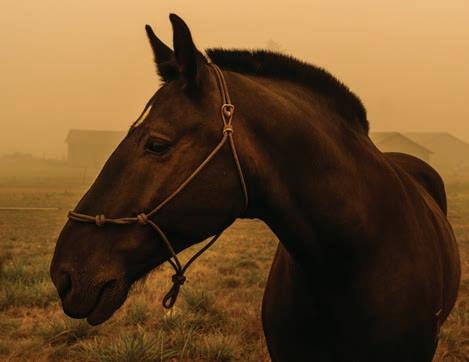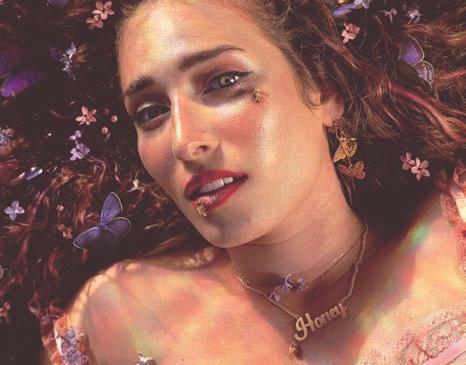
6 minute read
Letter Guy
GET...OUTSIDE?
Q(UARANTINE)&A
Advertisement
ALEX WITTWER
MANE EVENT: A horse near Sublimity, Ore., at the edge of the Beachie Creek Fire.
Vetting Process Veterinarians like Kate
Schoenhals have been treating horses, llamas, cows, rabbits and even a couple of emus displaced by the Oregon wildfi res. Last week, thousands of Oregonians were displaced by wildfi res. Hundreds of their pets and livestock were, too. To house the farm animals, expo centers and fairgrounds in Portland, Salem, Corvallis and Albany have been converted into temporary boarding facilities for farm animals whose owners have had to fl ee from the fi res. Kate Schoenhals is one of the Oregon State University veterinarians leading the visits to livestock evacuation sites. Schoenhals, who specializes in equine care, has spent most of her time in the fi eld reassuring owners that their animals are safe and o ering advice on how to make each animal’s temporary living situation more comfortable. But she estimates that since evacuations began, she alone has had to treat 75 to 100 animals that required veterinary intervention. “Fortunately, it wasn’t like the burns and scary things that you might expect with a fi re. It was just associated with the chaos of having to mass evacuate,” says Schoenhals. “I really think that getting the animals out sooner rather than later is key to survival.”
WW talked to Schoenhals about the scene on the ground and what it’s like to treat a horse su ering from
BY SHANNON GORMLEY
sgormley@wweek.com
smoke inhalation.
WW: What’s the scene like at those large evacuation sites?
Kate Schoenhals: Both Linn County and Benton County fairgrounds are where they house fair animals, so they have at least the means of setting up temporary pens and housing for large volumes of animals. It’s usually not this last minute. It looked like a giant makeshift boarding facility, with all di erent species. They housed chickens, rabbits, llamas, alpacas, sheep, goats, pigs, horses—the only things missing were dogs and cats because people kept them with their people.
What are some of the common injuries you’re treating?
Fortunately, a lot of people were evacuating their large animals and livestock when they were getting Level 1 and 2 evacuation warnings. It seemed like a lot of it was preemptive—those horses and cattle weren’t in an actual fi re before they were evacuated. There were some respiratory issues associated with smoke inhalation, and also with being shipped into a community housing pool where bugs and germs can be shared that aren’t usually shared. Mostly, honestly, it was things like lacerations experienced from the trauma and stress of transport. There was a horse that had a pretty good wound after having to ford a river to evacuate.
How do you treat a horse that has been inhaling wildfi re smoke?
There is no magic cure or treatment. It’s mostly just rest and supportive care. We had a few that came down with infl uenza, which is a virus shared across horses even when there isn’t smoke in the air. I think the smoke exacerbated the situation, and they got even more sick than they otherwise would have been. So they ended up with some secondary bacterial infections. We treated those with antibiotics. Honestly, the rain clearing out the air was key. It’s essentially supportive care, just trying to get them through and keeping them eating, drinking, pooping and peeing. See the full video interview at wweek.com/distant-voices.
HEAR THIS Just Like Honey
Soul singer Moorea Masa’s new single is at once deeply personal and widely relevant.
Though her second album has been completed since February, Portland soul singer Moorea Masa felt that releasing new music amid the turmoil of this year didn’t feel right. Until now. “I had a lot to process,” she says, “but it feels like what I’m writing about is relevant to right now, and I can release music in a meaningful way.” “Honey,” her appropriately smooth new single, is inspired by her tumultuous relationship with her mother, a Black woman who has struggled with mental illness for much of her life. “Everything that I’m doing for this album—and this song specifi cally—is to bring awareness to mental health and wellness in the BIPOC community,” Masa says. “I think about my mom, and I wish she would’ve had more access to the same resources that a lot of white folks do.” For the virtual single release party, Masa has teamed up with Musicians in Solidarity—a local organization working to bring diversity training to music venues—to raise money
COURTESY OF MOOREA MASA

MOOREA MASA
for Radical Rest, another local organization o ering free wellness services for BIPOC (see page 17). Additionally, the fi rst $500 in sales from “Honey” will be donated to an organization supporting Black Lives Matter. “There’s so much trauma in our world right now,” Masa says. “For a long time I wasn’t sure what my place was in all of it. But now I really want to put all my energy into organizations who are supporting BIPOC prosperity and wellness.” LAUREN KERSHNER. Moorea Masa plays her virtual single release show Friday, Sept. 25, at instagram.com/mooreamasa. 7:30 pm. Donations to Radical Rest encouraged.
ONLINE The Writing on the Wall
Portland artist Michael James Schneider’s viral balloon messages have inspired both praise and derision. He’s fi ne with either.
COURTESY OF MICHAEL JAMES SCHENIDER

MICHAEL JAMES SCHNEIDER
Michael James Schneider knows you’re making fun of him. He doesn’t particularly care. It’s unlikely you’ve made it this far in 2020 without having some of Schneider’s work cross your social media feeds. Scroll through Twitter or Instagram and, at any given moment, you might come across the Portland artist’s short-cropped beard and thickrimmed glasses, standing against a brightly colored wall, next to a message spelled out using infl ated balloons. It could be an inspirational quote, a reminder not to text an ex in the middle of a pandemic, or a statement accusing Donald Trump of simultaneously being racist and a rapist. He gets a lot of earnest shares and retweets, sure. But lately, Schneider has become ubiquitous enough to inspire a backlash. Detractors have called his work faux-woke and performative, cringy or fl atout sad. “I’m not saying that the letter balloon guy is the nation’s worst person, I’m simply stating that he’s in the conversation,” read one Tweet. He’s even inspired a meme generator allowing users to create parody versions. Schneider is aware of the criticisms. But he’s just kept on creating—mainly because he’s not doing this for anyone other than himself. “I’m a little selfi sh in my art in that I make it for myself. I make art to make the lambs stop screaming,” he says. “There’s something really calming, centering and grounding about making my art that has helped me get through what has been a really, really shitty year for most people.” But that’s not to say Schneider—who previously went viral for a project in which he “married” a boyfriend he built out of used wine boxes—doesn’t want to fi nd an audience. After all, everyone is going through this shitty year at the same time. It’s why he’s spent 2020 using his platform to push political messages and raise awareness for social causes. And while his main objective is to quell his own anxieties and insecurities, it never hurts to hear from people who relate to those same feelings. “It makes me feel great when so many other people—total strangers all over—can relate to what my headspace looks like at a given moment and can resonate with the words just as strongly as I do,” he says. “That online popularity is validating, but I know it’s place. I’m not creating for an audience to get as many online dopamine hits as possible.” SAM HILL.










